Global Capacitor Market: By Structure, By Type, By Voltage, By End Use Industry, By Region & Segmental Insights Trends and Forecast, 2024 – 2034
- Industry: Semiconductors & Electronics
- Report ID: TNR-110-1125
- Number of Pages: 420
- Table/Charts : Yes
- June, 2024
- Base Year : 2024
- No. of Companies : 10+
- No. of Countries : 29
- Views : 10048
- Covid Impact Covered: Yes
- War Impact Covered: Yes
- Formats : PDF, Excel, PPT
A capacitor is an electronic component that stores electrical energy in an electric field. It is composed of two conductive plates separated by an insulating material called a dielectric. When a voltage is applied across the plates, an electric field is created, causing a buildup of electric charge on the plates. Capacitors are characterized by their capacitance, measured in farads (F), which indicates the amount of electric charge they can store per unit voltage. Capacitors are widely used in various electronic circuits for a range of purposes, including filtering, buffering, and energy storage. They can smooth out voltage fluctuations, filter noise from signals, and provide temporary power in electronic devices. There are different types of capacitors, such as ceramic, electrolytic, and tantalum, each with specific properties suited for particular applications. The versatility and importance of capacitors make them fundamental components in modern electronics, contributing to the functionality and stability of countless devices.
The demand for capacitors is driven by several key factors. The rapid growth of consumer electronics, such as smartphones, tablets, and laptops, requires compact and efficient energy storage solutions. The increasing complexity and miniaturization of electronic devices boost the need for high-performance capacitors. Additionally, advancements in automotive technology, particularly in electric vehicles (EVs) and hybrid vehicles, demand capacitors for power management and energy storage. The expansion of renewable energy systems, like solar and wind power, also fuels the demand, as capacitors play a critical role in energy conversion and storage. Overall, the evolving landscape of technology and energy solutions continually drives the growth and innovation in the capacitor market. In terms of revenue, the global capacitor market was worth US$ 35.8 Bn in 2023, anticipated to witness CAGR of 6.2% during 2024 – 2034.
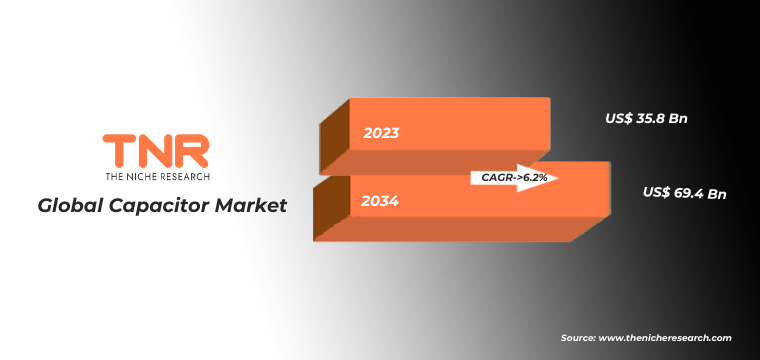
Global Capacitor Market Dynamics
Consumer Electronics: The proliferation of smartphones, tablets, laptops, and other portable devices increases the demand for compact and high-performance capacitors. The rise of electric vehicles (EVs) and hybrid vehicles requires advanced capacitors for power management and energy storage. Growth in solar and wind energy systems boosts the need for capacitors in energy conversion and storage applications.
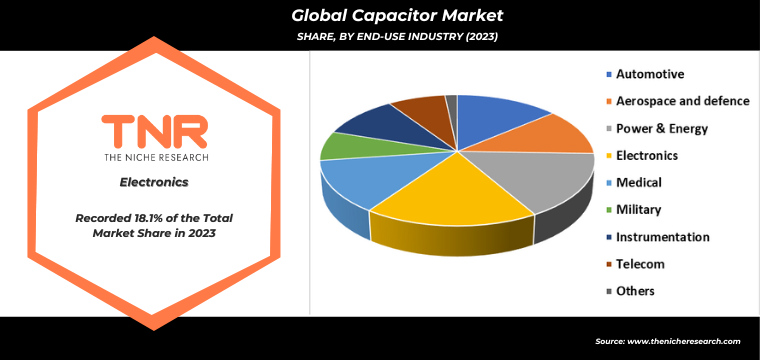
Supply Chain Disruptions: Raw material shortages and manufacturing challenges can impact the availability and cost of capacitors. Fluctuations in the prices of raw materials, such as tantalum and aluminium, can affect production costs and pricing strategies. Stringent environmental regulations regarding the disposal and recycling of electronic components can pose challenges to manufacturers.
Technological Innovation: Ongoing research and development in capacitor technology present opportunities for creating more efficient, durable, and application-specific capacitors. Increasing industrialization and digitalization in emerging economies offer significant growth potential for the capacitor market. The expansion of the Internet of Things (IoT) and the rollout of 5G networks drive the demand for capacitors in new and advanced communication devices and infrastructure. The push towards sustainable energy solutions opens opportunities for capacitors in grid storage and management systems.
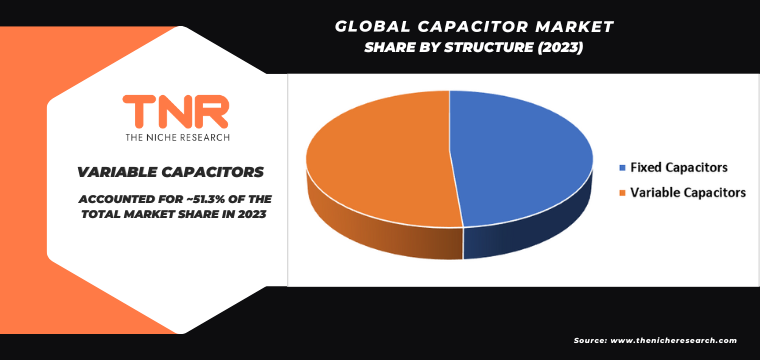
Ceramics Capacitors Segment Has Garnered Major Market Share in the Global Capacitor Market During the Forecast Period (2024 – 2034).
Ceramic capacitors, known for their reliability and versatility, are in high demand due to several key drivers. The rapid proliferation of consumer electronics, including smartphones, tablets, and laptops, necessitates the use of compact and efficient capacitors for power regulation and signal processing. In the automotive sector, the shift towards electric vehicles (EVs) and hybrid vehicles significantly boosts the demand for ceramic capacitors, which are essential for various power management and electronic control systems. Additionally, the expansion of telecommunications infrastructure, particularly with the rollout of 5G networks, increases the need for high-performance capacitors to handle higher frequencies and data rates. Industrial automation and the Internet of Things (IoT) further drive the demand, as these capacitors are critical in ensuring stable and reliable operation of automated systems and connected devices. The push towards renewable energy sources also contributes to market growth, with ceramic capacitors playing a vital role in energy conversion and storage applications. Consequently, the diverse applications and growing technological advancements across multiple sectors continue to fuel the demand for ceramic capacitors.

By Voltage Low Voltage Segment had the Highest Share in the Global Capacitor Market in 2023.
Low voltage capacitors, essential components in modern electronics, are experiencing high demand driven by several key factors. The surge in consumer electronics, including smartphones, tablets, laptops, and wearable devices, significantly boosts the need for these capacitors due to their role in power regulation, signal processing, and energy storage. The automotive industry’s rapid evolution, especially with the rise of electric and hybrid vehicles, further fuels demand as these capacitors are crucial for various electronic control systems, infotainment units, and battery management systems. The expansion of the Internet of Things (IoT) adds another layer of demand, as numerous connected devices require reliable capacitors to ensure stable operation and efficient energy usage. Additionally, the shift towards renewable energy systems, such as solar panels and wind turbines, necessitates low voltage capacitors for energy conversion and storage applications. Industrial automation, with its increasing reliance on precise electronic controls and efficient power management, also significantly contributes to the growing market. Moreover, advancements in technology, including the miniaturization of electronic components and the development of more efficient and durable capacitor materials, enhance their applicability and performance, further driving their adoption across various sectors. This confluence of technological advancements and expanding applications underscores the robust demand for low voltage capacitors.

By Region, North America Dominated the Global Capacitor Market in 2023.
In North America, the demand for capacitors is driven by several key factors across diverse industries. The region’s strong consumer electronics market significantly contributes to capacitor demand, as capacitors are integral to the functioning of smartphones, laptops, tablets, and other personal electronic devices. The burgeoning automotive industry, particularly the shift towards electric vehicles (EVs) and hybrid vehicles, is another critical driver. These vehicles require capacitors for battery management systems, powertrain electronics, and various onboard electronics, enhancing vehicle performance and efficiency.
The rise of renewable energy projects in North America also plays a significant role in boosting capacitor demand. Wind and solar energy systems depend on capacitors for efficient energy conversion, storage, and distribution. Additionally, the expansion of 5G technology and telecommunications infrastructure increases the need for capacitors in advanced communication systems to handle higher data rates and ensure reliable signal transmission. Industrial automation and the Internet of Things (IoT) further drive the demand for capacitors in North America. Factories and smart devices rely on capacitors for precise electronic controls, power management, and maintaining operational stability. The region’s focus on technological innovation and the continuous development of advanced electronic components also contribute to the growing capacitor market. These multifaceted demand drivers collectively underscore the robust and expanding capacitor market in North America.
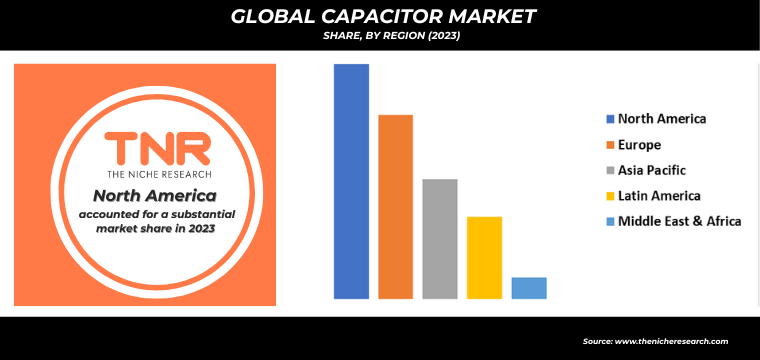
Competitive Landscape: Global Capacitor Market:
- AVX Corporation
- Holyoke Electronics Corporation
- Illinois Capacitor, Inc.
- KEMET Corporation
- Knowles Electronics, LLC.
- Murata Manufacturing Co., Ltd.
- Nichicon Corporation
- Nippon Chemi-Con Corporation
- Panasonic Corporation
- Samsung Electro-Mechanics Co., Ltd.
- TDK Corporation
- Vishay Intertechnology, Inc.
- Würth Elektronik eiSos GmbH & Co. KG, Deutschland
- Other Market Participants
Global Capacitor Market Scope
| Report Specifications | Details |
| Market Revenue in 2023 | US$ 35.8 Bn |
| Market Size Forecast by 2034 | US$ 69.4 Bn |
| Growth Rate (CAGR) | 6.2% |
| Historic Data | 2016 – 2022 |
| Base Year for Estimation | 2023 |
| Forecast Period | 2024 – 2034 |
| Report Inclusions | Market Size & Estimates, Market Dynamics, Competitive Scenario, Trends, Growth Factors, Market Determinants, Key Investment Segmentation, Product/Service/Solutions Benchmarking |
| Segments Covered | By Structure, By Type, By Voltage, By End Use Industry, By Region |
| Regions Covered | North America, Europe, Asia Pacific, Middle East & Africa, Latin America |
| Countries Covered | U.S., Canada, Mexico, Rest of North America, France, The UK, Spain, Germany, Italy, Nordic Countries (Denmark, Finland, Iceland, Sweden, Norway), Benelux Union (Belgium, The Netherlands, Luxembourg), Rest of Europe, China, Japan, India, New Zealand, Australia, South Korea, Southeast Asia (Indonesia, Thailand, Malaysia, Singapore, Rest of Southeast Asia), Rest of Asia Pacific, Saudi Arabia, UAE, Egypt, Kuwait, South Africa, Rest of Middle East & Africa, Brazil, Argentina, Rest of Latin America |
| Key Players | AVX Corporation, Holyoke Electronics Corporation, Illinois Capacitor, Inc., KEMET Corporation, Knowles Electronics, LLC. , Murata Manufacturing Co., Ltd., Nichicon Corporation, Nippon Chemi-Con Corporation , Panasonic Corporation, Samsung Electro-Mechanics Co., Ltd., TDK Corporation, Vishay Intertechnology, Inc., Würth Elektronik eiSos GmbH & Co. KG, Deutschland |
| Customization Scope | Customization allows for the inclusion/modification of content pertaining to geographical regions, countries, and specific market segments. |
| Pricing & Procurement Options | Explore purchase options tailored to your specific research requirements |
| Contact Details | Consult With Our Expert
Japan (Toll-Free): +81 663-386-8111 South Korea (Toll-Free): +82-808- 703-126 Saudi Arabia (Toll-Free): +966 800-850-1643 United Kingdom: +44 753-710-5080 United States: +1 302-232-5106 E-mail: askanexpert@thenicheresearch.com
|
Global Capacitor Market
By Structure
- Fixed Capacitors
- Non-Polarized
- Polarized
- Variable Capacitors
- Tunning Capacitor
- Trimmer Capacitor
By Type
- Ceramic Capacitors
- SMD Type
- Lead Type
- Film Capacitor
- Paper Film Capacitors
- Plastic Film Capacitors
- Electrolytic capacitors
- Tantalum capacitors
- Niobium capacitors
- Aluminum capacitors
- Super Capacitors
- Mica Capacitors
- Glass Capacitors
- Others
By Voltage
- Low Voltage
- Medium Voltage
- High Voltage
By End-Use industry
- Automotive
- Aerospace and defense
- Power & Energy
- Electronics
- Medical
- Military
- Instrumentation
- Telecom
- Others
By Region
- North America (U.S., Canada, Mexico, Rest of North America)
- Europe (France, The UK, Spain, Germany, Italy, Nordic Countries (Denmark, Finland, Iceland, Sweden, Norway), Benelux Union (Belgium, The Netherlands, Luxembourg), Rest of Europe)
- Asia Pacific (China, Japan, India, New Zealand, Australia, South Korea, Southeast Asia (Indonesia, Thailand, Malaysia, Singapore, Rest of Southeast Asia), Rest of Asia Pacific)
- Middle East & Africa (Saudi Arabia, UAE, Egypt, Kuwait, South Africa, Rest of Middle East & Africa)
- Latin America (Brazil, Argentina, Rest of Latin America)
Report Layout:
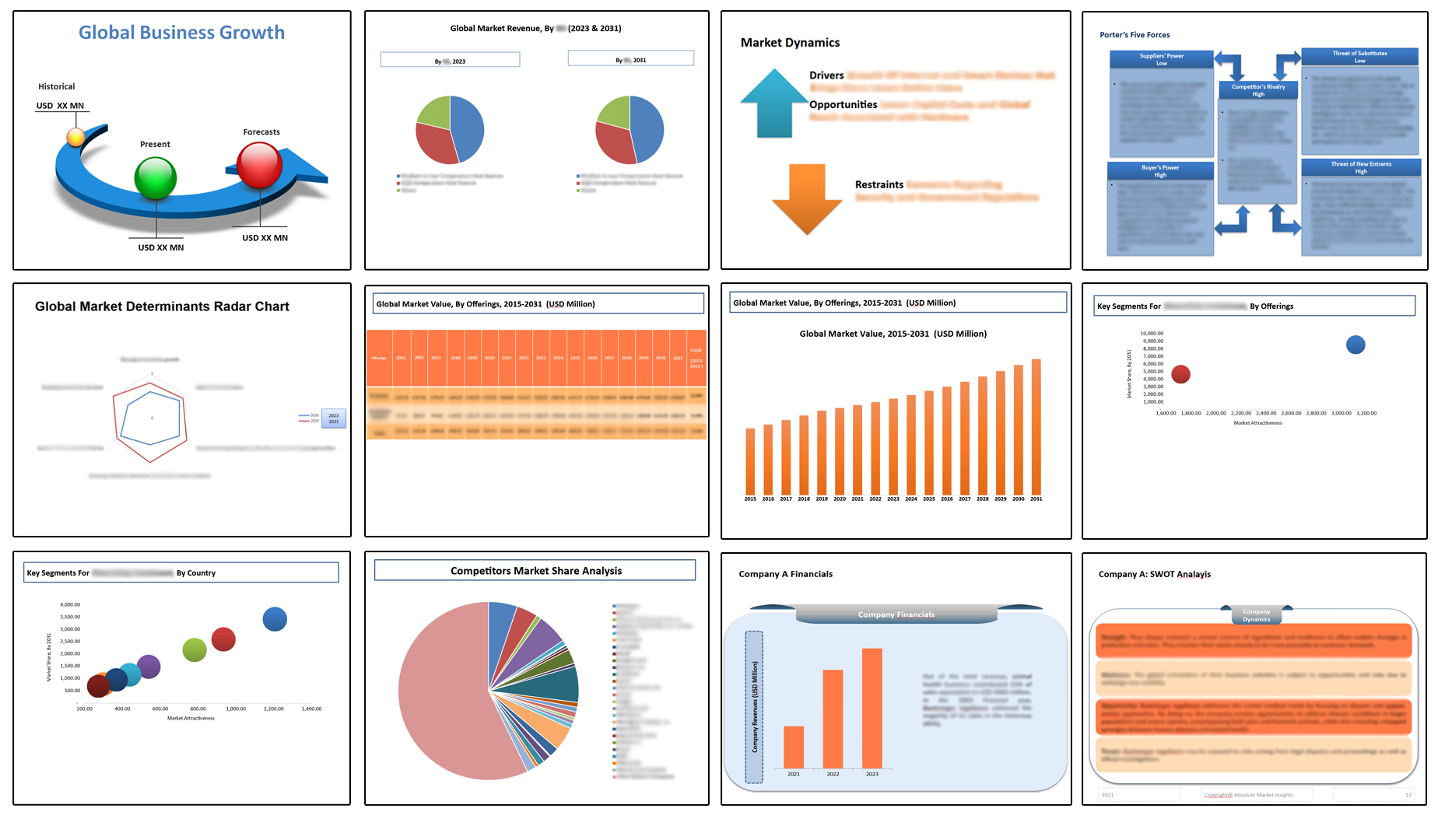
Table of Contents
Note: This ToC is tentative and can be changed according to the research study conducted during the course of report completion.
**Exclusive for Multi-User and Enterprise User.
Global Capacitor Market
By Structure
- Fixed Capacitors
- Non-Polarized
- Polarized
- Variable Capacitors
- Tunning Capacitor
- Trimmer Capacitor
By Type
- Ceramic Capacitors
- SMD Type
- Lead Type
- Film Capacitor
- Paper Film Capacitors
- Plastic Film Capacitors
- Electrolytic capacitors
- Tantalum capacitors
- Niobium capacitors
- Aluminum capacitors
- Super Capacitors
- Mica Capacitors
- Glass Capacitors
- Others
By Voltage
- Low Voltage
- Medium Voltage
- High Voltage
By End-Use industry
- Automotive
- Aerospace and defense
- Power & Energy
- Electronics
- Medical
- Military
- Instrumentation
- Telecom
- Others
By Region
- North America (U.S., Canada, Mexico, Rest of North America)
- Europe (France, The UK, Spain, Germany, Italy, Nordic Countries (Denmark, Finland, Iceland, Sweden, Norway), Benelux Union (Belgium, The Netherlands, Luxembourg), Rest of Europe)
- Asia Pacific (China, Japan, India, New Zealand, Australia, South Korea, Southeast Asia (Indonesia, Thailand, Malaysia, Singapore, Rest of Southeast Asia), Rest of Asia Pacific)
- Middle East & Africa (Saudi Arabia, UAE, Egypt, Kuwait, South Africa, Rest of Middle East & Africa)
- Latin America (Brazil, Argentina, Rest of Latin America)
The Niche Research approach encompasses both primary and secondary research methods to provide comprehensive insights. While primary research is the cornerstone of our studies, we also incorporate secondary research sources such as company annual reports, premium industry databases, press releases, industry journals, and white papers.
Within our primary research, we actively engage with various industry stakeholders, conducting paid interviews and surveys. Our meticulous analysis extends to every market participant in major countries, allowing us to thoroughly examine their portfolios, calculate market shares, and segment revenues.
Our data collection primarily focuses on individual countries within our research scope, enabling us to estimate regional market sizes. Typically, we employ a bottom-up approach, meticulously tracking trends in different countries. We analyze growth drivers, constraints, technological innovations, and opportunities for each country, ultimately arriving at regional figures.Our process begins by examining the growth prospects of each country. Building upon these insights, we project growth and trends for the entire region. Finally, we utilize our proprietary model to refine estimations and forecasts.
Our data validation standards are integral to ensuring the reliability and accuracy of our research findings. Here’s a breakdown of our data validation processes and the stakeholders we engage with during our primary research:
- Supply Side Analysis: We initiate a supply side analysis by directly contacting market participants, through telephonic interviews and questionnaires containing both open-ended and close-ended questions. We gather information on their portfolios, segment revenues, developments, and growth strategies.
- Demand Side Analysis: To gain insights into adoption trends and consumer preferences, we reach out to target customers and users (non-vendors). This information forms a vital part of the qualitative analysis section of our reports, covering market dynamics, adoption trends, consumer behavior, spending patterns, and other related aspects.
- Consultant Insights: We tap into the expertise of our partner consultants from around the world to obtain their unique viewpoints and perspectives. Their insights contribute to a well-rounded understanding of the markets under investigation.
- In-House Validation: To ensure data accuracy and reliability, we conduct cross-validation of data points and information through our in-house team of consultants and utilize advanced data modeling tools for thorough verification.
The forecasts we provide are based on a comprehensive assessment of various factors, including:
- Market Trends and Past Performance (Last Five Years): We accurately analyze market trends and performance data from preceding five years to identify historical patterns and understand the market’s evolution.
- Historical Performance and Growth of Market Participants: We assess the historical performance and growth trajectories of key market participants. This analysis provides insights into the competitive landscape and individual company strategies.
- Market Determinants Impact Analysis (Next Eight Years): We conduct a rigorous analysis of the factors that are projected to influence the market over the next eight years. This includes assessing both internal and external determinants that can shape market dynamics.
- Drivers and Challenges for the Forecast Period:Identify the factors expected to drive market growth during the forecast period, as well as the challenges that the industry may face. This analysis aids in deriving an accurate growth rate projection.
- New Acquisitions, Collaborations, or Partnerships: We keep a close watch on any new acquisitions, collaborations, or partnerships within the industry. These developments can have a significant impact on market dynamics and competitiveness.
- Macro and Micro Factors Analysis:A thorough examination of both macro-level factors (e.g., economic trends, regulatory changes) and micro-level factors (e.g., technological advancements, consumer preferences) that may influence the market during the forecast period.
- End-User Sentiment Analysis: To understand the market from the end-user perspective, we conduct sentiment analysis. This involves assessing the sentiment, preferences, and feedback of the end-users, which can provide valuable insights into market trends.
- Perspective of Primary Participants: Insights gathered directly from primary research participants play a crucial role in shaping our forecasts. Their perspectives and experiences provide valuable qualitative data.
- Year-on-Year Growth Trend: We utilize a year-on-year growth trend based on historical market growth and expected future trends. This helps in formulating our growth projections, aligning them with the market’s historical performance.
Research process adopted by TNR involves multiple stages, including data collection, validation, quality checks, and presentation. It’s crucial that the data and information we provide add value to your existing market understanding and expertise. We have also established partnerships with business consulting, research, and survey organizations across regions and globally to collaborate on regional analysis and data validation, ensuring the highest level of accuracy and reliability in our reports.








